The debt ceiling debate is all over the news, but it’s a different ceiling is commanding more of the bond market’s attention. Still, we wouldn’t say the debt ceiling is irrelevant, so let’s take a brief moment to address its implications for the housing and mortgage markets.
The most direct effect of the debt ceiling debate is a general ebb and flow of risk sentiment in the market. If it’s resolved without issue, investors may be slightly more interested in buying stocks and selling bonds. The latter puts upward pressure on interest rates and it was the general theme this week.
The 10yr Treasury yield is a good benchmark for rate momentum. Some of this week’s upward momentum may be attributed to potential progress on the debt ceiling, but we really didn’t see any compelling evidence that traders were on the edge of their seats over political drama. It would take a true “default” on US debt to roil markets, and that’s tremendously unlikely.
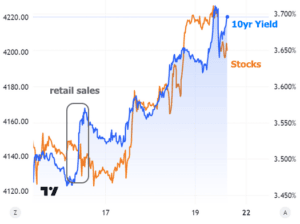
Markets found the Fed and the economic outlook to be much more worthy of attention this week. Retail Sales data on Tuesday morning set the tone for the week. Traders were more receptive to the slew of Fed speakers who echoed the same general sentiment: the fight against inflation is far from over and the data will determine when the Fed is done hiking rates.
At the start of the month, just after the last Fed meeting, market participants had almost fully priced out additional rate hikes. By the end of this week, we’re back up to nearly a 50% chance of another hike in June (rate outlook of 5.0% moved up to 5.11%, which is about half of a 0.25% rate hike).

The Fed’s comments and the economic data had an even bigger impact on longer-term rate expectations. Here’s how the market view’s December’s Fed meeting:
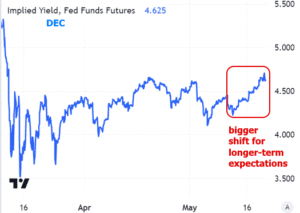
Economic data remains mixed. There are certainly ways to conclude it spells trouble for the economy, but there is resilience on several fronts. Even though Retail Sales could be considered underwhelming in month-over-month terms, it has held up far better than many analysts expected relative to how far above trend it has been.
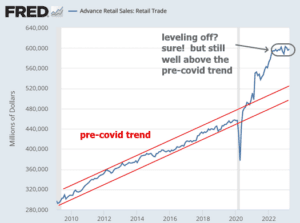
More of the negative evidence against the economy is seen in the most rate-sensitive sectors like housing. This week’s Existing Home Sales numbers weren’t terribly encouraging.
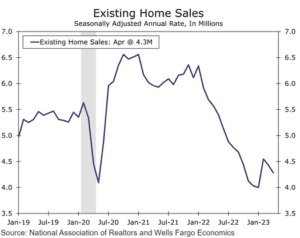
But it’s worth remembering that ultra low inventory is not just a talking point for housing market cheerleaders. It’s legitimately suppressing sales numbers. Incidentally, it also stands as evidence that 2023 is nothing like 2008.
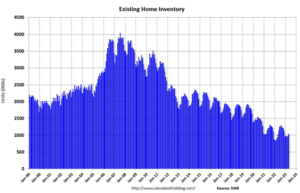
Things are a bit better for the new home market since builders don’t have to wait for a home seller to decide to move or refinance before those units come to market. Construction numbers show a moderate correction from the highs, but are still in line with the pre-covid trend.

Builders had been pretty bummed about the surge in interest rates in 2022, but this week’s NAHB Index (essentially “builder confidence”) suggests their mood is improving. The index rose from 45 to 50, handily beating the median forecast of 44.

The economic resilience and the Fed’s reminders about the rate outlook came at a time where the bond market was increasingly running out of room to maneuver inside the prevailing range. The result is a breakout from that range, seen most easily in terms of 10yr Treasury yields moving over 3.60%.
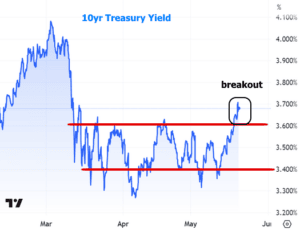
And to reiterate, the 10yr yield is a good benchmark for mortgage rates. They broke out too.
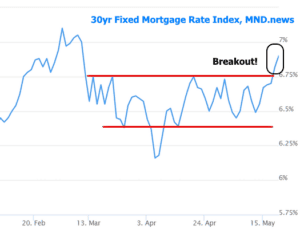
These breakouts mean that the market isn’t oblivious to the risk that it’s not yet time for the big reversal toward lower rates. The saving grace is that the market also isn’t convinced rates need to be any higher than they were earlier this year or late last year. Sure, we may be breaking the ceiling of the more narrow, more recent range, but there’s a longer-term consolidation that remains very much intact. This is the debate that we feel will take weeks or even months to resolve.

In the meantime, volatility can pop up inside these ranges. There will be ups and downs depending on data and events. Next week’s biggest tickets in that regard the PCE inflation data on Friday and a slew of additional Fed speeches throughout the week.
Subscribe to my newsletter online at: http://mortgageratesupdate.com/acelandmortgage
